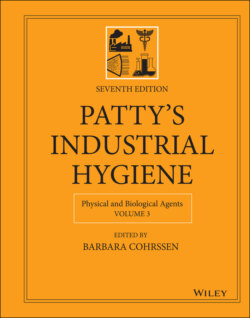Читать книгу Patty's Industrial Hygiene, Physical and Biological Agents - Группа авторов - Страница 115
4.1.2.3 Retinal Thermal Hazard
ОглавлениеThermal damage to the retina may occur when the rate at which optical radiation is absorbed and converted to thermal energy (heat) exceeds the rate at which heat can be dissipated. Heat is transferred by conduction to tissues adjacent to the portion of the retina on which the image of the optical source is formed. Because dissipation of heat takes time, a dose of optical radiation received in a very short period has greater potential to do thermal damage than the same dose received over a longer period. A small retinal image dissipates heat more efficiently than a large retinal image. The size of the retinal image depends on the angle subtended by the radiant source at the viewer's eye. Therefore, the retinal thermal hazard depends not only on the spectral radiance of the source but also on the exposure duration and potentially on the angular subtense of the source. The ACGIH TLV for protection against retinal thermal injury from a visible light source is defined in terms of a weighted radiance LR (20):
(15)
where Lλ is the source spectral radiance expressed in W cm−2 sr−1 nm−1 and R(λ) is the retinal thermal hazard function. R(λ) is plotted in Figure 9. Alternatively, for viewing durations less than 0.25 seconds, the TLV can be expressed as in terms of the time‐integrated radiance dose DLR, with units of J cm−2 sr−1. This allowable dose limit decreases with decreasing viewing duration (or pulse length) from 0.25 seconds down to 1 μs. For viewing durations greater than 0.25 seconds, the TLV is expressed solely in terms of the radiance LR, which for sources subtending an angle greater than 0.1 rad should not exceed 45 W cm−2 sr−1 (20). The ICNIRP exposure limit under these conditions is 28 W cm−2 sr−1 (19), owing to a modestly greater safety factor than that incorporated into the TLV. For viewing durations greater than 0.25 seconds and sources with an angular subtense less than 0.1 rad, the TLV or ICNIRP exposure limit may be increased by a factor equal to one‐tenth the inverse of the angular subtense in radians. For viewing times shorter than 0.25 seconds, more complicated conditions apply for when the exposure limit may be adjusted by the angular subtense, and these conditions differ between ICNIRP (19) and the ACGIH (20).
FIGURE 9 ACGIH retinal hazard functions (20). Dimensionless weighting factors for the blue‐light retinal hazard function B(λ), the aphakic hazard function A(λ), and the retinal thermal hazard function R(λ). Note that B(λ) and A(λ) coincide at wavelengths longer than 440 nm, and B(λ) and R(λ) coincide between 380 and 440 nm.
Source: From Ref. (20). Reprinted with permission of ACGIH.
IR heat lamps and other IR‐A sources may not emit sufficient visible radiation to stimulate the aversion response or pupillary constriction. A lower exposure limit is therefore recommended for extended viewing (>0.25 seconds) of such sources than is recommended for visible light sources. The TLV for protection against retinal thermal injury from an IR‐A source in the absence of strong visible light is given by the following weighted radiance in W cm−2 sr−1 (20):
for exposure times less than 810 seconds, where α is the angular subtense of the source in radians and t is the viewing duration in seconds. For exposure times longer than 810 seconds, the allowable weighted radiance is 0.6/α W cm−2 sr−1 (20). The ICNIRP exposure limit for IR sources with weak visual stimulus is a retinal‐hazard‐weighted radiance that is a factor of 1.6 lower than the value given by the right‐hand side of Eq. (16) for exposure durations up to 100 seconds and has value of 0.63/α W cm−2 sr−1 for durations greater than 100 seconds (19).
